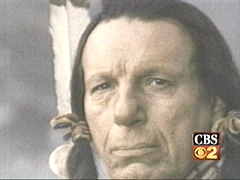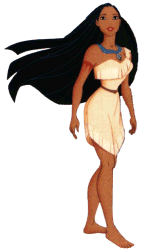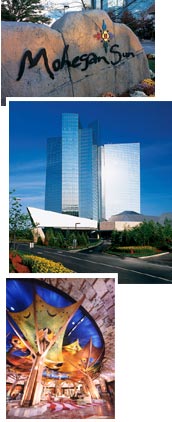 Another Stereotype of the Month entry:
Another Stereotype of the Month entry:
 Another Stereotype of the Month entry:
Another Stereotype of the Month entry:
Sopranos defend Columbus against Indians
From Indian Country Today:
American Indians 5, Sopranos 0 – but with honors
Posted: October 07, 2002 -- 7:00am EST
Some people say there is no such thing as bad publicity, but they are not quite right. There is bad publicity. The media — both journalistic and dramatic — can twist Native identities and issues around like distortions in a trick mirror. It can even make you hate yourself.
But that's not what happened the other Sunday night, Sept. 29, on "The Sopranos", the hugely successful HBO Original series, when Tony Soprano and the boys suddenly entered Indian country. The episode, which featured a Native American sub-plot, left a long way to go in how Indians are portrayed in media but it hit a lot of good points. Our take: the episode marks a new depth for a major television show on an Indian theme. The hope now is that the thematic will grow.
The plot was not quite predictable. It had a Soprano style of its own, threatening violence that does not quite explode. Tony, Silvio Dante, the made men and their boys, were chatting it up when the subject of Columbus came up. According to the paper, Indians were about to demonstrate against the Jersey Columbus Day parade. Turns out Columbus as Italian hero touches a chord with the Soprano guys, especially with Dante (played here ironically by Steven Van Zandt), who is indignant that Indians would call Columbus a villain. Instigated by Dante, the Soprano guys go after the Indians who would demonstrate. A dramatically rewarding tension builds, if hampered by Indian characters that are a bit too predictable. Predictability is what happens to Indians on almost all television dramas. First the warrior, then the spiritual guru, then as noble but defeated antagonist of yesterday's plot, who, some will charge, becomes the Indian campus radical, and now is delivered the casino tribal chairman of today's re-emerging Indian world.
To be sure, there are plenty of stereotypes to go around, including, some argue, the Italian caricatures inherent in the very premise of "The Sopranos". Television breeds it. In this entertaining episode all three major Indian characters in the show had bases in contemporary Indian reality. For instance, the casino chairman is supposedly only marginally Indian, with a "rediscovered" identity. This is a stereotype. Many casino CEOs and chairpersons of casino tribes emerge from deeply rooted Indian families. Similarly, the two campus radicals, the Indian professor and his good-looking Native assistant were just too consistently in the angry mode. That went out some time ago.
Still, the show had plenty of redemption. In fact, we thought the Indians emerged victorious at least five times. The Soprano boys went up against contemporary Indians and came up short on every count. It was American Indians 5, Sopranos 0.
First, on the street, Silvio, Furio and the gang show up at the Indian rally. They push and shove with Indian protesters. For the first time in memory, the Soprano boys get pushed out of the place. As they retreat, a bottle flies from the Indian side that smashes a Soprano man on the back of the head. They have to carry him out and basically get run off. Score one.

Next, Tony phones a politician normally in his pocket. He tells the corrupt but tough old pol, "Stop these Indian protestors." The pol won't touch it, even if it's a request from Tony. "Its Native American, untouchable," says the Pol. Tony starts to get resigned to the idea. Score two.
The mafiosi Sopranos then try another idea. They will threaten to "expose" the revelation that Iron Eyes Cody was not really Indian. They go to the angry Indian professor. But he will not back down as his brilliant and beautiful Indian research grad student comes up with factual evidence that Cody was indeed an Indian. In this case, the Indians out-research the Mob. Score three.
Next, the Soprano boys, in some consternation, try going to the Indian casino CEO, from the fictitious and perceptual composite Mohonk Tribe, which has lots of money and influence. The Indian CEO tries but can't quite persuade the indignant professor to give up his demonstration. Nevertheless, he cleverly hosts Tony and the boys, then compromises them to "get him Frankie Valli," beating the Soprano boys of yet another favor. Score four.
Defeated on the street, out-influenced with the local politician, out-researched by the Indian academics, out-bested by a casino CEO, Tony goes home where he finds the topic also dominating domestic conversation. But even at home, the Indian argument cannot be bested. While wife Carlotta frets and fumes about the anti-Columbus "idiocy," son "Anthony" walks around reading from the history book, telling his parents that the Indians are right, "it's in the book," Columbus was a jerk. Score five.
American Indians 5, Sopranos 0.
Finally, the Soprano boys are in a conversation with a Jewish gangster and a Cuban gangster. The Jewish gangster suddenly takes after them for his "history of oppression." The Cuban, exclaiming his Taino ancestry, calls Columbus a Hitler for enslaving and mass murdering his people. This explodes the whole conversation.
Score six? Moral of the story so far: don't mess with the Indians, who are coming on from many angles.
Congratulations to "The Sopranos" for its American Indian episode. It would be great to see at least one Indian character develop, within that project, beyond the fundamental profiled Indian identities. We hope the show will stay factual about Indian casinos and the minimal influence of organized crime on the Indian gaming establishments.
It is also important to note that there are good Indian-country relations with the folks behind the Sopranos' excursion into an American Indian context. Interestingly, the most virulent anti-Indian character in last week's drama, Silvio Dante, is played by Steven Van Zandt, who has a long history of direct involvement in and pragmatic support of Indian causes. It must have been particularly delightful and entertaining for him to play so effectively against type.
A Native response
From The Day:
Fact or Fiction?: Mohegan tribal chairman takes offense at ‘The Sopranos'
By Ann Baldellib
Published on 10/08/2002

Some people might be flattered to be depicted in a hugely popular television series, but Mark Brown is insulted.
The Mohegan tribal chairman, and others, believe the fictional Indian chief in the Sept. 29 episode of HBO's "The Sopranos" was likened after Brown. And to further the affront, the character was portrayed as an opportunist associating with the mob.
"I think most people who saw it would have to say that was supposed to be me," Brown said. "A lot of people did say to me that they thought it was me. But it wasn't me at all."
An HBO spokeswoman said the character, Doug Smith, was not supposed to be Mark Brown.
On television, Smith is chief of an Indian tribe that runs a lucrative casino in Connecticut. The tribe is called the Mohonks.
The names — Doug Smith and Mark Brown — and Mohonk and Mohegan — are too similar, said Brown. And the physical likeness of the character and the 45-year-old Brown are remarkably similar, too.
The white-faced, cleanly coiffed Smith even dressed like Brown, with a conservative suit coat and tie.
The fictitious chief boasts about his tribe's new quarter-of-a-billion-dollar, state-of-the-art casino, what sounds to Brown like a reference to the just-completed billion-dollar expansion at Mohegan Sun.
But what really irritates Brown is the dialogue between the mobsters and the television chief, who meet to discuss an American Indian protest of the annual Columbus Day festivities in New Jersey.
"No offense, chief, but you don't look much like an Indian," one of the wise guys comments.
"Frankly, I passed most of my life as white, until I had a racial awakening and discovered my Mohonk blood," says Smith. "My grandmother on my father's side, her mother was a quarter Mohonk."
"And this happened when the casino was built, right?" Tony Soprano asks.
"Better later than never," Smith replies.
Brown, who traces his Mohegan ancestry on his mother's side and whose family has been active in tribal government for decades, was working for the Mohegans before they were federally recognized in 1994 and served as a liaison to the tribe's Elder's Council before there was a casino.
His mother and grandmother served on the Tribal Council, and his great-grandfather, the late Burrill Fielding, better known as Chief Matahga, led the tribe from 1937 to 1952.
"So to make me look like I was somebody who came on board after there was a casino, no way," Brown said.
He's also disappointed, but not surprised, that writers for "The Sopranos" would include the line about Smith not looking like an American Indian.
"They can't do it to any other group, but we seem to be fair game," Brown said. "Personally, I think it's an attack on Indian Country."

American Indians are treated differently and often more unfairly than other groups, according to Amy Bass, a professor of history at Plattsburgh State University in upstate New York who specializes in race and ethnicity in popular culture.
"The only vision white Americans have of Indians is a white man's Indian, and that's an Indian of the past, not a contemporary view," Bass said. "The contemporary Indian, since the Indian movement of the 1970s ... it's not an image most Americans have."
When confronted with a modern American Indian, white Americans conjure up visions of Pocahontas or other storybook illustrations that they are comfortable with, Bass said.
She said she watched "The Sopranos" episode at issue and noted that remarking on the Indian's appearance is nothing new. In the early 1990s, Donald Trump made headlines when he told a congressional panel that the Mashantucket Pequots didn't look like Indians to him.
"Could Trump have said that about a black man? Absolutely not," Bass said.
No more than a sports team would be named for another ethnic group, like Italians or Jews.
"We still have the Redskins," Bass said. "But do you think we would ever have the San Diego Wops or the Baltimore Kikes? Absolutely not."
In episode of "The Sopranos" episode with Doug Smith, the chief unsuccessfully tries to intervene to stop the Columbus Day protest by American Indians. It turns out that he can't help, but he invites the mob figures to his casino for a day of gambling and freebies.
The New Jersey wise guys are pictured at the casino, and there's a private conversation between Chief Smith and Boss Tony Soprano, where the Smith asks the mobster to help him book Frankie Valli at the casino.
"Frankie Valli?" asks Brown, who has been the tribal chairman since October 2000, and is serving his second five-year term on the Mohegan Tribal Council.
Normally, he doesn't watch "The Sopranos," he said, but he was given a taped copy of the Sept. 29 episode.
"Maybe I'm reading too much into this, but my concern is the way this portrayal could affect the tribe," he said.
The Mohegans sought federal recognition in 1978, a decade before the federal legislation allowing casinos on Indian reservations was passed, he said. They've also been above board in all their professional dealings, and would never knowingly associate with mob figures, he said.
A former police officer, son of a career military man and the father of four, Brown said he was personally offended by the characterization that the fictitious chief would so willingly meet with the mobsters.
"The story was probably not done with malicious intent, but it could taint the perception of some as to the legitimacy of the Mohegans," he said.
"Chief Doug Smith is not based on Mark Brown," said the HBO spokeswoman, who declined to answer other questions and refused to give her name.
Some of "The Sopranos" cast members are expected to visit Mohegan Sun for a private trade show later this month, and the casino's radio station hosted a Sopranos' party for listeners last month, to kick off the new season of the popular show.
The cast also has appeared at Foxwoods Resort Casino at least twice in the last year, at private parties for high rollers, according to casino spokesman Bruce MacDonald.
Asked about the episode in question, MacDonald said: "I want to say absolutely nothing about ‘The Sopranos,' except that it is a very successful television show."

Rob's review
In 2006 I finally saw the episode "Christopher" (as in Columbus). Indian Country Today and The Day have covered the show and the issues well. Just a few comments:
In conclusion, it was smart of the creators to let the Indians come off looking good in most of the conflicts. If they hadn't, activists and academics (like me) would've lambasted them for their unfair portrayal of Indians.
Overall, "Christopher" was average in terms of the usual dramatics. It was implausible for the mobsters to handle so many conflicts passively—with phone calls and verbal protests. Usually they send in goons to bash heads whenever someone challenges them.
But the episode was above average in addressing racial issues. Its portrayals of Indians were less clichéd and more real than those you usually see on mainstream TV. As ICT wrote, the episode showed "new depth" in depicting urban Indian life.
For those who wish to see this episode, it's available on DVD. It's episode three of season four.
Related links
The facts about Indian gaming
|
. . . |

|
All material © copyright its original owners, except where noted.
Original text and pictures © copyright 2007 by Robert Schmidt.
Copyrighted material is posted under the Fair Use provision of the Copyright Act,
which allows copying for nonprofit educational uses including criticism and commentary.
Comments sent to the publisher become the property of Blue Corn Comics
and may be used in other postings without permission.